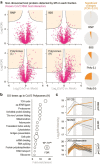This is a preprint.
SARS-CoV-2 Nsp1 regulates translation start site fidelity to promote infection
- PMID: 37461541
- PMCID: PMC10350044
- DOI: 10.1101/2023.07.05.547902
SARS-CoV-2 Nsp1 regulates translation start site fidelity to promote infection
Abstract
A better mechanistic understanding of virus-host interactions can help reveal vulnerabilities and identify opportunities for therapeutic interventions. Of particular interest are essential interactions that enable production of viral proteins, as those could target an early step in the virus lifecycle. Here, we use subcellular proteomics, ribosome profiling analyses and reporter assays to detect changes in polysome composition and protein synthesis during SARS-CoV-2 (CoV2) infection. We identify specific translation factors and molecular chaperones whose inhibition impairs infectious particle production without major toxicity to the host. We find that CoV2 non-structural protein Nsp1 selectively enhances virus translation through functional interactions with initiation factor EIF1A. When EIF1A is depleted, more ribosomes initiate translation from an upstream CUG start codon, inhibiting translation of non-structural genes and reducing viral titers. Together, our work describes multiple dependencies of CoV2 on host biosynthetic networks and identifies druggable targets for potential antiviral development.
Keywords: Coronavirus; Nsp1; SARS-CoV-2; proteomics; proteostasis; ribosomes; translation.
Conflict of interest statement
Declaration of interests All authors declare no competing interests.
Figures











References
Publication types
Grants and funding
LinkOut - more resources
Full Text Sources
Miscellaneous
